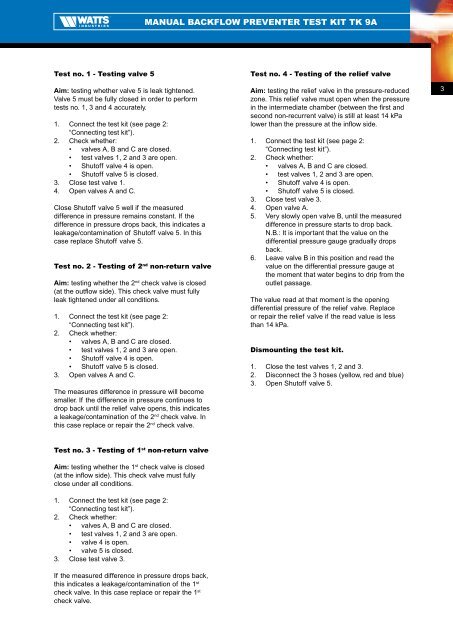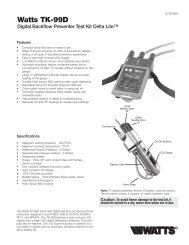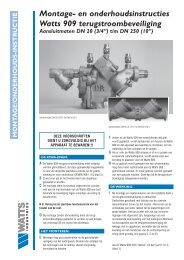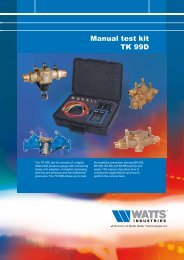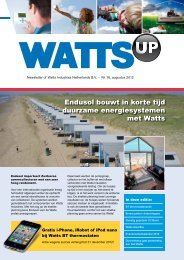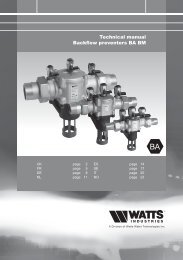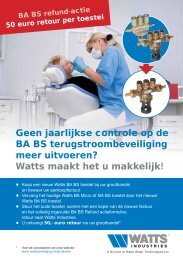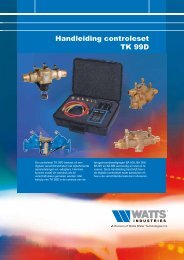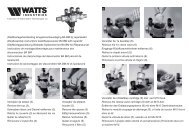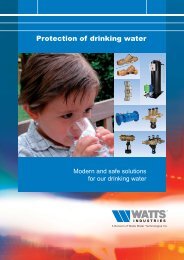Manual Backflow Preventer Test Kit TK 9A - Watts waterbeveiliging
Manual Backflow Preventer Test Kit TK 9A - Watts waterbeveiliging
Manual Backflow Preventer Test Kit TK 9A - Watts waterbeveiliging
Create successful ePaper yourself
Turn your PDF publications into a flip-book with our unique Google optimized e-Paper software.
<strong>Manual</strong> <strong>Backflow</strong> <strong>Preventer</strong> <strong>Test</strong> <strong>Kit</strong> <strong>TK</strong> <strong>9A</strong><br />
<strong>Test</strong> no. 1 - <strong>Test</strong>ing valve 5<br />
Aim: testing whether valve 5 is leak tightened.<br />
Valve 5 must be fully closed in order to perform<br />
tests no. 1, 3 and 4 accurately.<br />
1. Connect the test kit (see page 2:<br />
“Connecting test kit”).<br />
2. Check whether:<br />
• valves A, B and C are closed.<br />
• test valves 1, 2 and 3 are open.<br />
• Shutoff valve 4 is open.<br />
• Shutoff valve 5 is closed.<br />
3. Close test valve 1.<br />
4. Open valves A and C.<br />
Close Shutoff valve 5 well if the measured<br />
difference in pressure remains constant. If the<br />
difference in pressure drops back, this indicates a<br />
leakage/contamination of Shutoff valve 5. In this<br />
case replace Shutoff valve 5.<br />
<strong>Test</strong> no. 2 - <strong>Test</strong>ing of 2 nd non-return valve<br />
Aim: testing whether the 2 nd check valve is closed<br />
(at the outflow side). This check valve must fully<br />
leak tightened under all conditions.<br />
1. Connect the test kit (see page 2:<br />
“Connecting test kit”).<br />
2. Check whether:<br />
• valves A, B and C are closed.<br />
• test valves 1, 2 and 3 are open.<br />
• Shutoff valve 4 is open.<br />
• Shutoff valve 5 is closed.<br />
3. Open valves A and C.<br />
The measures difference in pressure will become<br />
smaller. If the difference in pressure continues to<br />
drop back until the relief valve opens, this indicates<br />
a leakage/contamination of the 2 nd check valve. In<br />
this case replace or repair the 2 nd check valve.<br />
<strong>Test</strong> no. 4 - <strong>Test</strong>ing of the relief valve<br />
Aim: testing the relief valve in the pressure-reduced<br />
zone. This relief valve must open when the pressure<br />
in the intermediate chamber (between the first and<br />
second non-recurrent valve) is still at least 14 kPa<br />
lower than the pressure at the inflow side.<br />
1. Connect the test kit (see page 2:<br />
“Connecting test kit”).<br />
2. Check whether:<br />
• valves A, B and C are closed.<br />
• test valves 1, 2 and 3 are open.<br />
• Shutoff valve 4 is open.<br />
• Shutoff valve 5 is closed.<br />
3. Close test valve 3.<br />
4. Open valve A.<br />
5. Very slowly open valve B, until the measured<br />
difference in pressure starts to drop back.<br />
N.B.: It is important that the value on the<br />
differential pressure gauge gradually drops<br />
back.<br />
6. Leave valve B in this position and read the<br />
value on the differential pressure gauge at<br />
the moment that water begins to drip from the<br />
outlet passage.<br />
The value read at that moment is the opening<br />
differential pressure of the relief valve. Replace<br />
or repair the relief valve if the read value is less<br />
than 14 kPa.<br />
Dismounting the test kit.<br />
1. Close the test valves 1, 2 and 3.<br />
2. Disconnect the 3 hoses (yellow, red and blue)<br />
3. Open Shutoff valve 5.<br />
3<br />
<strong>Test</strong> no. 3 - <strong>Test</strong>ing of 1 st non-return valve<br />
Aim: testing whether the 1 st check valve is closed<br />
(at the inflow side). This check valve must fully<br />
close under all conditions.<br />
1. Connect the test kit (see page 2:<br />
“Connecting test kit”).<br />
2. Check whether:<br />
• valves A, B and C are closed.<br />
• test valves 1, 2 and 3 are open.<br />
• valve 4 is open.<br />
• valve 5 is closed.<br />
3. Close test valve 3.<br />
If the measured difference in pressure drops back,<br />
this indicates a leakage/contamination of the 1 st<br />
check valve. In this case replace or repair the 1 st<br />
check valve.


